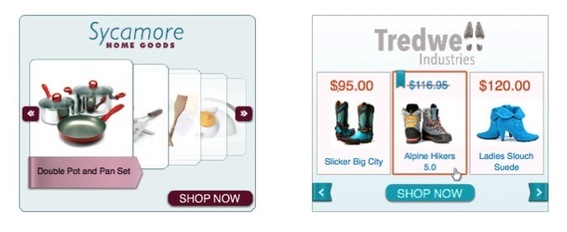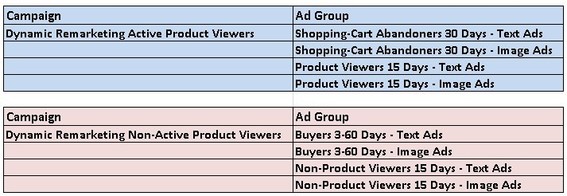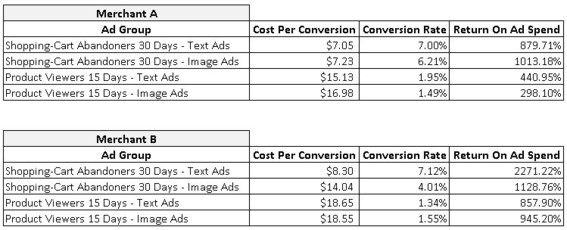Google recently announced the launch of a sophisticated new ad feature called Dynamic Remarketing. It works much the same as general remarketing, but the ad units showcase products that visitors viewed. If a shopper came to your site and viewed, say, a specific running shoe, you can insert details of that running shoe in Dynamic Remarketing ads that appear on other websites.
Examples of image-ad dynamic creatives.
My company was first alerted to Dynamic Remarketing in January when Google invited us to bring a few of our merchants into the beta testing. Over the last several months we have run Dynamic Remarketing campaigns and achieved impressive results while learning a great deal about the feature and its potential. In this article I will reference test data from two merchants and also share how their Dynamic Remarketing performance compared to legacy remarketing efforts. Before sharing these lessons, it’s important to understand how these campaigns are set up. Here is what we did when testing Dynamic Remarketing.
We Added Google’s New Dynamic Remarketing Code
The Dynamic Remarketing code Google AdWords requires you to implement on your site adds custom parameters that observe the product ID and category page that visitors see. Then, when future remarketing ads are shown to that visitor as they browse the rest of the Internet, those parameters allow the ad to dynamically pull product photos and information from your Merchant Center feed to make the ads the visitor sees more relevant.
We Created Remarketing Campaigns and Ad Groups in Google AdWords
Through AdWords we created two types of campaigns; one that targeted shoppers who actively viewed products, and one that targeted shoppers who hadn’t viewed products for an extended time period. These campaigns, along with their associated ad groups, were as follows.
Active Product Viewers
- Shopping-cart abandoners 30 days. Those visitors who abandoned their shopping cart in the last 30 days.
- Product viewers 15 days. Those visitors who didn’t add the viewed products to the cart in the last 15 days.
Non-active Product Viewers
- Buyers 3-60 days. Those visitors who bought products between 3 and 60 days ago.
- Non-product-viewers 15 days. Those visitors who did not visit product pages in the last 15 days.
Each campaign consisted of four ad groups. Only two of these ad groups were unique, as we duplicated the ad groups to compare image and text-only ads. Here is how our campaign breakout looked.
Campaign breakout example. Enlarge This Image
Enlarge This Image
Results and Lessons
After running Dynamic Remarketing campaigns for five months, we’ve identified key trends. This data comes from two of our merchants who average over 100,000 unique visitors a month.
Lesson 1: Increased Conversions on Cart Abandoners
Dynamic shopping cart abandoners’ ad groups showed impressive conversion and return-on-ad spend metrics compared to legacy shopping cart abandoners’ ad groups.
When comparing dynamic shopping cart abandoners’ ad groups to legacy shopping cart abandoners’ ad groups, conversion rate, cost per conversion, and return on ad spend (ROAS) were similar — and at times better, but the dynamic campaigns saw many more conversions. The table below showcases the metric changes between each remarketing type. The legacy ad groups ran from Sept. 1, 2012 to Jan. 31, 2013 while the dynamic ad groups ran from Feb. 1, 2103 to June 30, 2013.
Dynamic remarketing compared to legacy remarketing. Enlarge This Image
Enlarge This Image
A pleasantly surprising observation was how comparable the metrics were between each remarketing type. The legacy ad groups were running all of Q4, the busiest time of the year for many merchants, yet the dynamic remarketing ad groups saw more conversions.
Merchant A ended up seeing many improvements with the dynamic remarketing ad groups. Conversions increased by 88.57 percent while ROAS soared by 195.52 percent. Similarly, Merchant B saw a 169.23 percent increase in conversions while all other dynamic remarketing ad group metrics remained consistent with the legacy remarketing ad groups.
Lesson 2: Product Viewers Convert with Lower Returns
Going into this test, we were interested in the idea of remarketing to visitors based on which products they viewed, even if they didn’t get to the shopping cart. The product viewers’ ad groups allowed us to specifically target the highest-traffic category of visitors: shoppers who were still in comparison-shopping mode. We found that the product viewers’ ad groups showed much lower conversion rates and ROAS’ than the shopping cart abandoners, as evidenced in the table below.
The product viewers’ ad group converted at lower rates than shopping cart abandoners. Enlarge This Image
Enlarge This Image
We didn’t expect product viewers to have metrics as impressive as shopping cart abandoners, but we did hope to see numbers more in line with the account averages. Nonetheless, we were able to exclude non-performing websites, and we were able to lower bids, in order to keep the metrics more in line with our targets.
Lesson 3: Image Ads Are Seen The Most
By and large, the image ad units — i.e., the ads that contained product images — accounted for a majority of the total traffic in the Dynamic Remarketing campaigns. For both merchants in our test, image ads consisted of at least 66 percent of the total impressions and 72 percent of the total clicks. In fact, Merchant A saw 89 percent of clicks come from image ads. The takeaway is to make sure you are testing different image ad formats as these units will show the most.
Lesson 4: Product Non-viewers Aren’t As Profitable
Unsurprisingly, we didn’t see much traffic or conversions come from the product-non-viewers campaigns. The pool of buyers and shoppers who haven’t viewed a product in fifteen days is significantly smaller than those who actively view items. Merchant B’s non-viewers campaign only saw 7 percent of the impressions that the product-viewers campaign did. This statistic is very encouraging as it shows that shoppers are digging into product pages instead of just categories
In both accounts, we also noticed that non-viewer campaigns had a much higher cost per conversion and lower ROAS. However, the total cost in each of these campaigns was so low that overall metrics were only slightly affected. We were okay with the results because the cost was so low, but advertisers will have to make their own decisions as to what is acceptable.
Conclusion
We have been extremely happy with the overall performance of our merchants’ Dynamic Remarketing campaigns. These campaigns have allowed for product-level remarketing, going beyond the notion of just keeping the brand in front of shoppers. Dynamic Remarketing has shown to be a powerful feature and over time, will become a significant driver of profitable revenue for merchants who take advantage of it.



